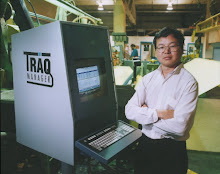Many mills use thermal transfer printers to print coretag labels to be placed in the core. Typical suppliers of these printers are Zebra, Sato, Printronix and others. Similar printers may be used at the backtender to print jumbo reel tickets and at the wrapline to print end labels or special bar-coded labels.
These thermal transfer printers use a single row of tiny heating elements (known as the print head) to melt the plastic ink from the ribbon which is transferred to a moving paper label (the coretag).
When the lines of barcodes are parallel to the movement of the label through the printer, the edges of the lines are typically very straight and crisp, making the code easier to read. This is referred to as printing the bar code in a "picket fence" format. See example below.

Conversely, when the lines of the bar code are perpendicular to the direction of the label stock through the printer, the edges of the lines tend to be fuzzy and irregular, making it more difficult to read with any bar code reading technology. This fuzziness can be visible and has greater negative impact on dense and small barcodes. This is referred to as printing the bar code in a "ladder" format. See example below.

A serious problem can occur if there is a single broken element or dirt on the printhead. This would result in a white or black line in the direction of the paper movement. In the case of the picket fence barcode, a line can appear parallel with the barcode bars and the barcode would be completely unreadable. See example below.

A similar line on the ladder barcode would degrade barcode scanning but is not as bad as the picket fence example above. As long as the scanner can cross all the bars of a barcode, it will read it in the barcode.

Conclusion: The picket fence barcodes are usually crisper because the print head makes the lines sharper. This is more critical when printing small barcodes which are not common in the paper industry. We recommend using ladder barcodes in most paper mill applications because the barcodes tend to be large and the fuzzy edges are undetectable by barcode scanners. With dust being common in the mill, minor print head failures are more common.

No comments:
Post a Comment